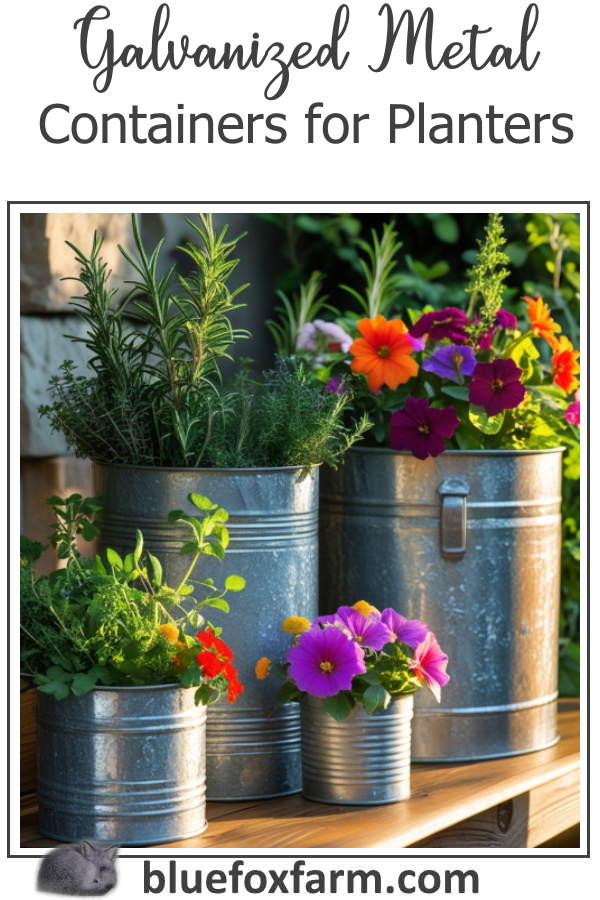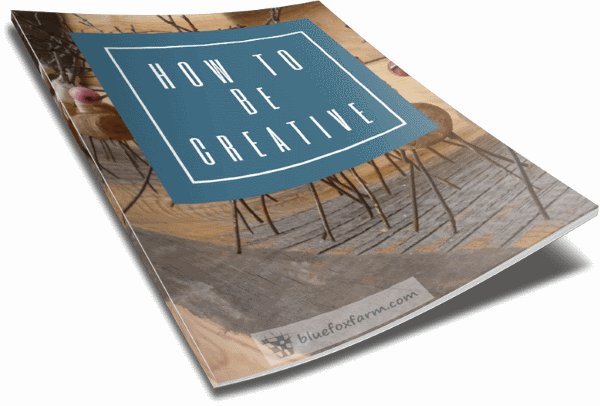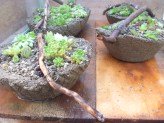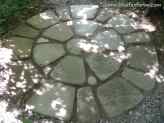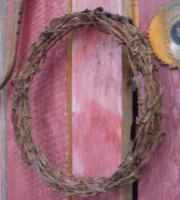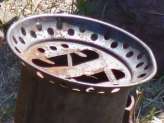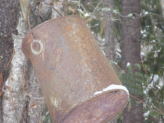Galvanized Metal Containers For Planters
What's In Your Stash?
Here's a guide on using Galvanized Metal Containers as Planters:
Types of Galvanized Containers to Look For
The world of vintage galvanized metal offers endless planting possibilities:
Large Containers:
- Wash tubs and laundry tubs (round or oval)
- Stock tanks and water troughs
- Feed troughs and grain bins
- Milk cans (tall and cylindrical)
- Mop buckets and utility pails
- Old bathtubs (galvanized or zinc-coated)
Medium Containers:
- Galvanized buckets in various sizes
- Sap buckets (maple syrup collection buckets)
- Coal scuttles and ash buckets
- Chicken feeders and waterers
- Vintage minnow buckets
- Old tool caddies and carriers
Small Containers:
- Drinking cups and dippers
- Small pails and berry buckets
- Funnels (hung upside down or mounted)
- Measuring scoops
- Lunch pails
- Sprinkling cans and watering pots
Specialty Items:
- Wheelbarrows
- Wagon beds
- Milk bottle carriers
- Wire egg baskets with metal bottoms
- Old mailboxes
- Vintage coolers
Where to Find Galvanized Treasures
Best Sources:
- Farm auctions and estate sales (especially rural areas)
- Flea markets and antique shops
- Architectural salvage yards
- Craigslist, Facebook Marketplace, and eBay
- Barn sales and farm cleanouts
- Thrift stores and secondhand shops
- Family farms (ask older relatives or neighbors)
- Antique malls and co-ops
What to Look For:
- Authentic rust and patina (adds character)
- Dents and dings (perfect for primitive style)
- Original labels or stamps (dairy names, manufacturer marks)
- Varied sizes for creating grouped displays
- Intact bottoms (or plan to line them)
Price Range:
Expect to pay anywhere from $5-10 for small buckets to $50-200+ for large wash tubs or milk cans, depending on condition, rarity, and location. Don't overpay—part of the fun is the hunt!
Preparing Galvanized Containers for Planting
Drainage is Essential:
Galvanized metal doesn't naturally have drainage holes, so you must create them: vintage pieces tend to be really thick, so generally you'll be using the first and third methods here.
- Drill Method:
Use a metal drill bit (1/4" to 1/2") and drill 4-8 holes in the bottom, depending on container size. Wear safety glasses and secure the container.
- Punch Method:
Use a hammer and large nail or awl to punch holes (works for thinner metal. Put a piece of wood inside, and turn the piece upside down to give you something to punch against.
- No-Drill Option:
Use containers as cachepots—place planted nursery pots inside and remove to water, allowing excess to drain before returning the plant. Using a saucer under the pot can help prevent damage in the form of more rust forming.
Dealing with Rust:
The patina is part of the charm, but manage it appropriately:
- Light Surface Rust:
Leave it! This is desirable for primitive decor
- Heavy Flaking Rust:
Wire brush loose pieces, then seal with clear matte spray if desired
- Rust Prevention:
Some gardeners apply a food-safe sealant to the interior, though this isn't necessary
- Embrace the Aging:
Remember that galvanized metal will continue to develop character over time.
Lining Options:
Consider lining containers to extend their life and protect plants:
- Landscape Fabric:
Line the bottom and sides, cut slits for drainage
- Coconut Coir Liner:
Natural and attractive if visible, so no need for perfection here
- Plastic Sheeting:
Use for containers with holes or thin spots, make sure there are drainage holes
- Burlap:
Adds rustic texture, though it will decompose over time
- No Liner:
Many gardeners plant directly without lining—galvanized metal is generally safe for plants
Soil and Planting Tips
Soil Mix:
Use quality potting mix, not garden soil:
- Container potting mix with good drainage
- Add perlite or vermiculite for extra drainage in large containers
- Mix in compost for nutrients
- Consider moisture-control potting mix for containers that dry quickly
Planting Technique:
- Add 1-2 inches of gravel or broken pottery at the bottom for drainage
- Fill with potting mix, leaving 2-3 inches from the rim
- Arrange plants while still in nursery pots to plan layout
- Remove plant from pot, take off a portion of root ball from bottom to prevent spiraling
- Plant, firm soil gently, and water thoroughly
- Top with decorative mulch if desired (pea gravel, bark, or moss)
Container Size Considerations:
- Small containers (under 1 gallon):
Single plants or herbs or small succulents like Sedum album.
- Medium containers (1-5 gallons):
Small groupings or larger single plants for a major impact, like a topiary or specimen plant.
- Large containers (5+ gallons):
Multiple plants, small shrubs, or vegetable garden.
Best Plants for Galvanized Containers
Flowers
Sun-Loving:
- Geraniums (classic country garden choice)
- Petunias and calibrachoa
- Zinnias and marigolds
- Lantana
- Verbena
- Portulaca (moss rose)
Shade-Tolerant:
- Impatiens and begonias
- Coleus (for foliage color)
- Fuchsia
- Ferns
- Hostas (in larger containers)
Trailing Plants for Edges:
- Sweet potato vine
- Trailing petunias
- Ivy and vinca vine
- Bacopa
- Lobelia
Herbs:
Perfect for galvanized buckets near the kitchen:
- Basil (multiple varieties)
- Rosemary
- Thyme and oregano
- Parsley and cilantro
- Sage
- Chives
- Mint (contained growth is actually beneficial)
- Lavender
Vegetables:
Galvanized tubs make excellent vegetable planters:
Large Containers:
- Tomatoes (determinate varieties or with support)
- Peppers
- Eggplant
- Cucumbers (with trellis)
- Squash and zucchini
Medium Containers:
- Lettuce and salad greens
- Kale and chard
- Bush beans
- Radishes
- Carrots (in deep containers)
Small Containers:
- Cherry tomatoes
- Herbs
- Green onions
- Spinach
Succulents and Drought-Tolerant Plants:
Excellent for low-maintenance displays:
- Sedums and sempervivums (hens and chicks)
- Echeveria
- Portulaca
- Ornamental grasses
- Lavender
Seasonal Bulbs:
- Spring: Tulips, daffodils, hyacinths, crocuses
- Summer: Dahlias, gladiolus, lilies
- Fall: Plant spring bulbs for next year
Design and Arrangement Ideas
Single Statement Piece:
One large wash tub or stock tank as a focal point:
- Fill with a lush mixed planting
- Place at a garden entrance or patio corner
- Use as a water garden with aquatic plants
- Create a miniature vegetable garden
Grouped Collection:
Arrange multiple containers of varying sizes:
Clustered Grouping:
- Use odd numbers (3, 5, or 7 containers)
- Vary heights with overturned crates or stands
- Mix sizes but keep a cohesive style
- Group near doorways, on porches, or in garden corners
Linear Arrangement:
- Line containers along a fence, walkway, or deck railing
- Use similar-sized containers for uniformity
- Plant with coordinating colors or themes
- Space evenly or cluster in groups
Tiered Display:
- Stack containers on old wooden crates or ladder shelves
- Create height variation for visual interest
- Ensure stability with larger containers at bottom
- Mix planted containers with empty decorative ones
Themed Collections:
Herb Garden:
- Group various galvanized buckets with different herbs
- Add primitive wooden plant markers
- Include vintage kitchen tools in the display
- Place near kitchen door for easy access
Cottage Garden:
- Mix flowers in romantic, overflowing arrangements
- Use weathered containers with heavy patina
- Add trailing plants for softness
- Incorporate watering cans and garden tools
Farmhouse Vegetable Garden:
- Plant edibles in large wash tubs
- Label with chalkboard signs
- Add vintage vegetable crates nearby
- Include tomato cages or trellises
Succulent Garden:
- Fill shallow containers with succulent arrangements
- Add decorative rocks or pebbles - a great way to display your shell or pebble collection, or even sea glass
- Group multiple small containers
- Perfect for hot, sunny locations
Vertical Displays:
Mounted Wall Planters:
- Attach small buckets to fence or wall with brackets
- Stagger heights for visual interest
- Plant with trailing or cascading plants
- Great for small spaces or vertical gardens
Hanging Planters:
- Use buckets with handles hung from decorative hooks
- Hang from pergolas, arbors, or porch ceilings
- Ensure secure attachment for weight
- Plant with trailing varieties
Ladder Display:
- Lean old wooden ladder against wall
- Set containers on rungs
- Mix planted and decorative containers
- Add primitive accessories
Repurposed Creative Uses:
Milk Can Planters:
- Plant tall flowers or grasses in full-size milk cans
- Use as porch sentinels flanking doorways
- Add house numbers painted on the side
- Group in odd numbers for impact
Trough Gardens:
- Create long, linear plantings in feed troughs
- Perfect for deck railings or fence tops
- Plant with uniform flowers or mixed arrangements
- Use for herb gardens or salad greens
Tiered Fountain Conversion:
- Stack graduated sizes with planted arrangements
- No water needed—just the visual effect
- Secure tiers with hidden supports
- Plant with cascading flowers
Beverage Station Conversion:
- Use large tubs as ice buckets for outdoor entertaining
- When not entertaining, fill with plants
- Dual-purpose functionality
- Perfect for patios and decks
Styling for Primitive Country Charm
Complementary Elements:
Enhance your galvanized planters with these additions:
Natural Materials:
- Weathered wood crates and boxes
- Barn wood backdrops
- Stone or brick bases
- Burlap and jute twine accents
Additional Galvanized Items:
- Watering cans (functional or decorative)
- Old lanterns
- Vintage signs
- Metal stars or horseshoes cut out of galvanized roofing
Primitive Accessories:
- Antique garden tools leaning nearby
- Straw hats or work gloves draped casually
- Wooden plant markers or signs
- Terra cotta pots mixed in
Vintage Touches:
- Old seed packets displayed
- Vintage garden catalogs
- Enamelware pieces
- Mason jars with cut flowers
Color Schemes:
Classic Primitive:
- Red geraniums with white alyssum
- Deep burgundy and rust tones
- Navy blue and cream
- Natural greens with white flowers
Cottage Garden:
- Soft pinks, lavenders, and whites
- Pastel color mixes
- Romantic, flowing combinations
- Lots of texture and variety
Modern Farmhouse:
- White and green only
- Monochromatic plantings
- Clean, simple arrangements
- Structured, less "wild" look
Rustic Harvest:
- Oranges, golds, and deep reds
- Autumn-toned flowers
- Ornamental peppers and kale
- Seasonal decorative elements
Placement Strategies
Porch and Entryway:
- Flank doorways with matching large containers
- Create welcoming displays on steps
- Hang small buckets from porch posts
- Group containers in corners
Garden Beds:
- Nestle containers among plantings
- Use as focal points in flower beds
- Create height variation
- Anchor corner plantings
Patio and Deck:
- Define seating areas with container groupings
- Line deck railings with trough planters
- Create privacy screens with tall plantings
- Add herb gardens near grilling areas
Pathways:
- Line walkways with evenly spaced containers
- Mark path entrances with larger statement pieces
- Create rhythm with repeated plantings
- Guide visitors through garden spaces
Unexpected Locations:
- Mount on fence posts
- Place in tree branches (small, secure containers)
- Float in ponds or water features
- Tuck into garden nooks and crannies
Seasonal Transitions
Spring:
- Bright bulbs and cool-season annuals
- Fresh greens and herbs
- Pastel color schemes
- Light, airy arrangements
Summer:
- Heat-tolerant flowers and vegetables
- Lush, full plantings
- Bold, vibrant colors
- Maximum growth and abundance
Fall:
- Mums, ornamental kale, and cabbage
- Pumpkins and gourds added to arrangements
- Warm autumn colors
- Harvest-themed displays
Winter:
- Evergreen branches and berries
- Birch logs and pinecones
- Dried arrangements
- Holiday lights and decorations
- Empty containers as sculptural elements
Maintenance and Care
Watering:
Galvanized containers dry out faster than ground plantings:
- Check moisture daily in hot weather
- Water thoroughly until it drains from bottom
- Morning watering is best
- Consider self-watering inserts for large containers
- Group containers with similar water needs
Fertilizing:
Container plants need regular feeding:
- Use slow-release fertilizer mixed into soil at planting
- Supplement with liquid fertilizer every 2-3 weeks
- Follow package directions for container plants
- Reduce feeding in fall as plants slow growth
Deadheading and Pruning:
Keep plants looking their best:
- Remove spent flowers regularly
- Trim leggy growth to encourage bushiness
- Remove yellowing leaves
- Refresh tired plants mid-season with new ones
Pest and Disease Management:
Monitor container plants regularly:
- Inspect for aphids, spider mites, and other pests
- Ensure good air circulation
- Avoid overwatering to prevent root rot
- Remove affected leaves promptly
- Use organic pest control methods when needed
Winter Protection:
In cold climates:
- Empty containers and store indoors, or
- Leave planted with evergreens and winter interest
- Elevate containers on pot feet for drainage
- Move valuable pieces to protected locations
- Metal can crack if water freezes inside—ensure drainage
Creative Advanced Projects
Galvanized Container Water Garden:
- Use large wash tub or stock tank
- Add aquatic plants (water lilies, lotus, water lettuce)
- Include small fountain pump for movement
- Add goldfish for mosquito control
- Create a peaceful water feature
Tiered Herb Garden:
- Stack graduated sizes of galvanized tubs
- Secure with hidden supports or rebar
- Plant different herbs in each tier
- Easy access and great drainage
- Space-saving vertical garden
Mobile Container Garden:
- Attach casters to bottom of large tub
- Create movable garden for sun-chasing
- Easy to rearrange for entertaining
- Bring tender plants indoors for winter
Galvanized Raised Bed:
- Use large stock tanks as raised bed gardens
- Add foam or other material in the bottom, takes less soil
- Excellent drainage and soil control
- Warmer soil for earlier planting
- Accessible height for easy gardening
- Modern farmhouse aesthetic
Budget-Friendly Tips
Save Money:
- Shop off-season at antique stores
- Look for damaged pieces (holes add drainage!)
- Check free sections of online marketplaces
- Ask farmers and rural neighbors
- Buy in bulk at farm auctions
- Start small and build your collection over time
DIY Alternatives:
- New galvanized buckets from hardware stores ($5-15)
- Spray paint plastic containers with metallic paint
- Use galvanized trash cans (new or vintage)
- Repurpose household galvanized items
Maximize Your Investment:
- Choose versatile sizes that work for multiple uses
- Buy quality pieces that will last for years
- Refresh plantings seasonally in same containers
- Use as both planters and decorative storage
Safety Considerations
Galvanized Metal and Plants:
- Modern galvanized coating is generally safe for plants
- Some concern about zinc
Learn what it takes to be creative - we all have the gene but how do we develop it? Get the free guide!
Fill in the form below for your copy;
(Don't be disappointed - use an email address that will accept the free download - some .aol email addresses won't.
If you don't see your download within a few minutes, try again with another email address - sorry for the bother.)
